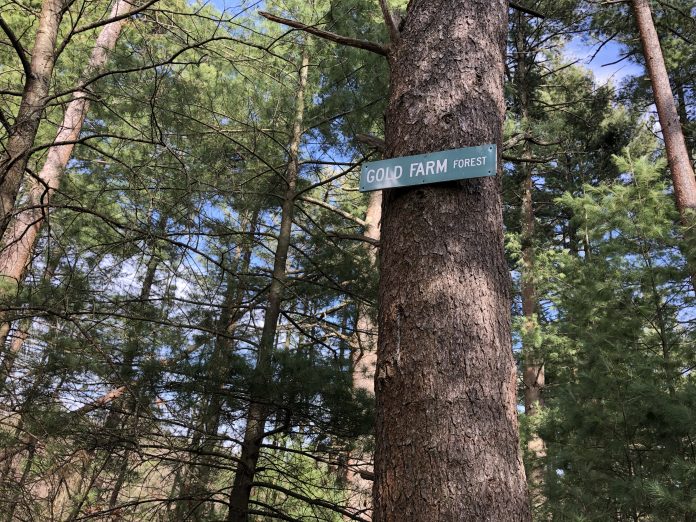NORTH SMITHFIELD – A project that could see some 67 acres of land along Mattity Road made available to residents for hiking and recreation – while another 37 acres is used for solar development – is back under consideration, with developers requesting relocation of a conservation easement to accommodate the project.
Attorney John Mancini, working on behalf of owner Marcia Gold, appeared before the North Smithfield Town Council Monday night with the case for removing property restrictions on a 10-acre portion of her land to allow for construction of a 9.5 megawatt solar array.
A master plan for the same project received a positive recommendation from the Planning Board in July of 2020, but the development also required relief from multiple zoning restrictions, which zoners ultimately denied.

“We then took that denial from the Zoning Board and filed an action in Superior Court appealing the decision,” Mancini said.
According to the attorney, the owner has also since moved forward with developing an alternative plan that would not require zoning approval: development of a 90-unit housing project.
“The reality is, it’s viable, good land,” Mancini said. “It’s unreasonable to think that this would never be built.”
The option proposed once again on Monday, Oct. 16, would instead see the entire 125 acre parcel of land, known as Gold Forest, given to the town, with a section for the array leased back to the developer for energy production for a period of 25 years, with potential for a five year extension. The scenic land features multiple hiking trails and unique historic features, including a former piggery.
“This is an opportunity for the town to get this property in its entirety,” Mancini said.
It’s an opportunity that’s been considered in various forms by various town boards for several years.
Former owner David Gold had negotiated an agreement with the town back in 2018 that would have utilized a $400,000 grant from the Department of Environmental Management to purchase the land – with no contingencies. But the deal failed to garner favor with enough councilors following an election that saw changes in town leadership.
In 2019, the Gold family returned with the a new project containing a solar element – the design later denied by zoners due in part, to the size of the proposed array and amount of relief required.
Gold, who had built and maintained a system of marked trails looping through waterways and the various unique features on his land, opened it to the public in 2020 as a way for locals to escape from pandemic-related stress. He died in August of that same year.
Now, with ligation still in the balance, it is his wife Marcia working to see the entire parcel turned over to the town for recreation – with the solar array to be built and then decommissioned following the lease period.
“The goal of the property owner and the applicant is to convey to the town the entire parcel,” Mancini said.

But first, the attorney said, a conservation easement described as, “highly restrictive,” would need to be modified via an agreement with the council. The easement, which covers a triangular parcel by the roadway at the center of the proposed array, prohibits all activity, including recreation, according to Mancini.
“It doesn’t allow for anything,” he said. “No one can benefit from it.”
As part of the deal, the town would also receive $5,000 in taxes per megawatt of power generated by the solar farm.
“The town would get the property, and it would get the revenue,” said Mancini.

A map shown by Mancini shows the triangular easement, the proposed solar array in purple and the piece for recreation/conservation in pink.
The attorney pushed for a contingent removal of the easement subject to final plan approval and permitting from the Rhode Island Department Environmental Management. He noted that as part of the project, connecting trails would be developed and, thanks to more recent access gained to a portion across Mattitty Road, parking would be added. Conservation, he said, could be moved to the larger recreation area, which abuts Tarkiln Pond.
“It will be developed in a manner that will compliment what is there,” said Mancini.
Planning Board Vice Chairman Jeffrey Porter told councilors they should review minutes from his board’s ruling on the project back in 2020. Planners voted 3-2 in favor of the recommendation, but then took a second vote recommending the council deny efforts to remove the easement, a decision Councilor Douglas Osier noted seemed like a contradiction.
Councilors ultimately took Porter’s advice, voting to review the Planning Board meeting minutes and reconvene on the issue at the next Town Council meeting.
Osier noted the solar project would be preferable to the alternative.
“This land is going to look a lot different if 90 houses go there,” Osier said. “Putting a lot of housing developments in that area could change the makeup of this town and remove a lot of the rural character.”
“It is a beautiful piece of property,” said Osier.








“conservation easement described as, “highly restrictive. “It doesn’t allow for anything,” he said. “No one can benefit from it.” There is a reason there is a conservation easement. But hey, for the almighty dollar, we can ignore it. Just put the “line” elsewhere….. WHAT???? Let’s put in the fear factor now, ” 90 units”. Good luck on that one.
No developer is buying that land for homes, especially in this market. Too many areas of wetlands and that brook would require a bridge or two. There’s a huge expense in engineering those wetlands, crossing streams, building roads and bridges.
Rankin Brook and the Swamp would cause major hurdles to a developer.
AND WE DON’T NEED MORE SOLAR PANELS IN NORTH SMITHFIELD!
Don’t we have enough already?
Jason’s certainly right, building in that area is a nightmare due to the various protected habitats. Though he’s also an abutter so
JoshW, I am not an abutter nor am I even close enough to see it.
We wouldn’t be in a situation of deciding between solar or housing if certain town councilors had recognized the benefits of this “beautiful piece of property “ and purchased it for recreation using the state grant and funds from the open space bond passed in 2006.
Now the choice is between bad and worse.
Or a hard pass….